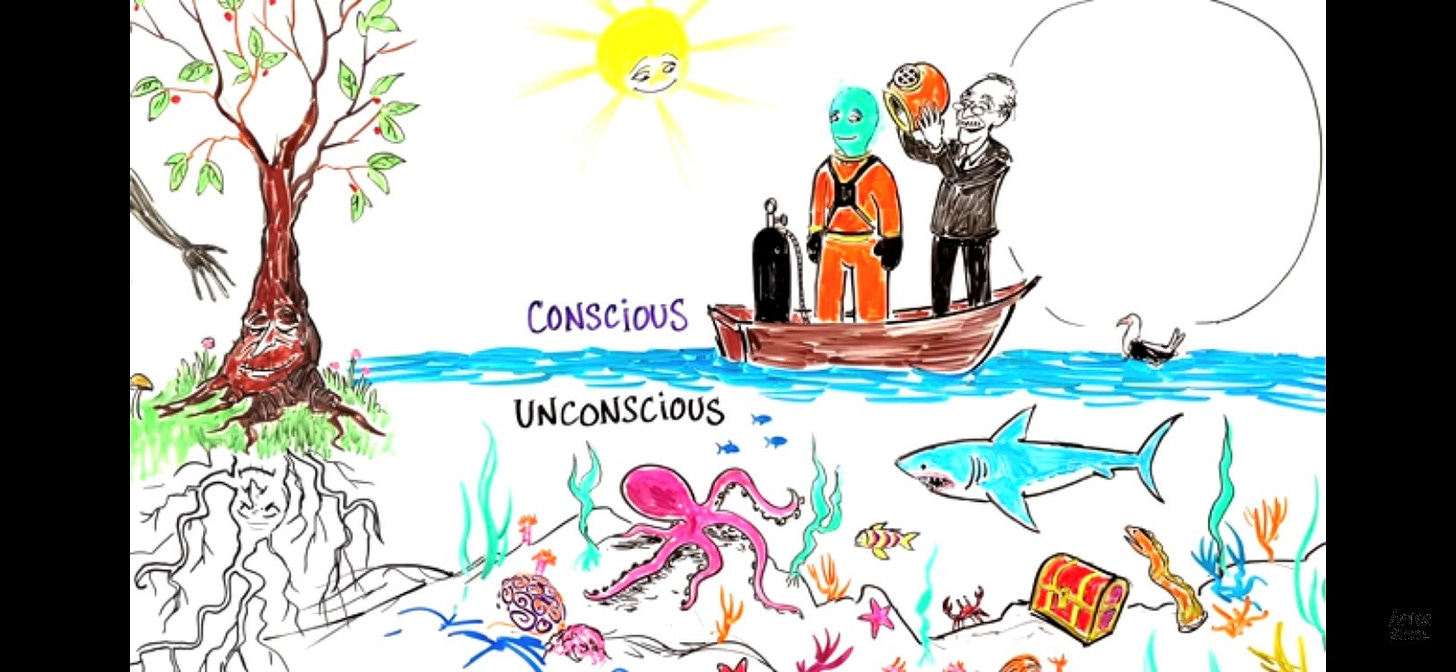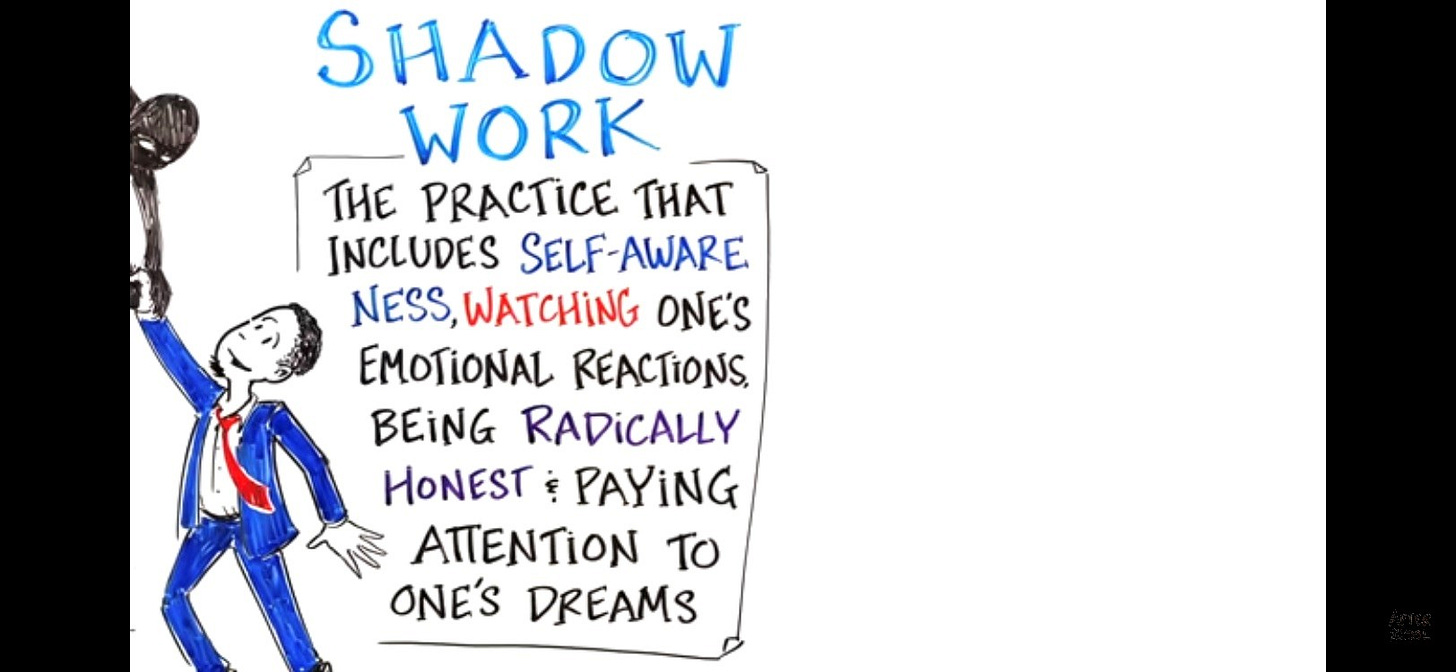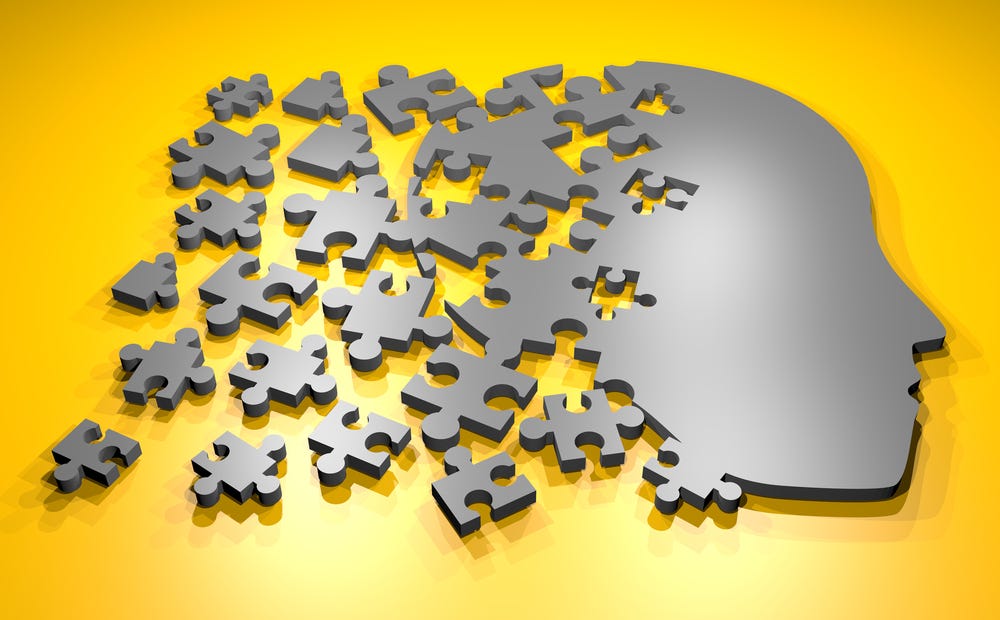"Unconscious denial of any experience freezes some portion of our available energy in shadow." Why shadow work (exploring the subconscious mind) is vital for improving our life, and how yoga helps.
The subconscious mind is wildly powerful. And it doesn't learn or function like the conscious mind.
Contents
The Subconscious: What it Is & How it Works
The All-Encompassing Impact of the Subconscious
Key to Freedom & Power: Shadow Work (Exploring the Subconscious)
Step One of Dismantling Unhelpful Programming
Why & How Yoga is So Helpful
Resources
Recent Newsletters
We thank yoga teacher Diana Benigno for research and writing contributions.
The Subconscious Mind Controls the Autonomic Nervous System and is thus “the Operating System of the Body”
The subconscious mind is the operating system of the body. It controls heart rate, digestion, blood sugar levels, body temperature, hormonal secretions, temperature regulation, and more. Thus, if we can consciously tap into the autonomic nervous system, we can begin to influence the way our body functions physiologically.
While We’re Mentally Focused, the Subconscious is Working Behind the Scenes
Right now you’re primarily using your conscious mind to read these words and absorb their meaning, but beneath that mental focus, your subconscious mind is busily working behind the scenes, absorbing or rejecting information based on an existing perception you have of the world around you. This existing perception began forming when you were an infant. With every experience, your subconscious mind soaks in information like a sponge. It rejected nothing while you were young because you didn’t have any pre-existing beliefs to contradict what it perceived. It simply accepted that all of the information you received during your early childhood was true... By the time you were 7 or 8 years old, you already had a solid foundation of belief based on all that programming from people in your life, television shows you watched, and other environmental influence.
“The fragmented, unintegrated past… appears as… a preprogrammed path… The unconscious denial of any experience freezes some portion of our available energy in shadow, thereby restricting our freedom and movement.”
From a mystic’s (or Jungian’s) perspective, every experience or emotion from the past that remains unacknowledged, unprocessed, or denied is stored in the realm of the unconscious, or shadow. These experiences have not been integrated by the psyche or spirit, and so they will — indeed, they must — surface again and again in new but familiar forms. What we think of as destiny is in fact the unintegrated past. And the fragmented, unintegrated past appears always as a false future of repetition, a preprogrammed path along which every individual and every culture sets out until the contents of that past have been brought into the light of consciousness, reconciled and healed... We may choose to understand these repetitions of shadow content as karma, a Sanskrit word originally meaning “effect” or “fate” (i.e., destiny). Or we may recognize them in light of our contemporary understanding as trauma — specifically as retraumatization, the unconscious act of repeating the conditions of earlier traumas upon self and others... While our will is our own, our choices are inevitably bound and restricted by karma, by trauma, by what we conceive of as “the past” — all that we have denied, disowned, dissociated, and suppressed. The unconscious denial of any experience freezes some portion of our available energy in shadow, thereby restricting our freedom and movement. With every denial or suppression of the past, we create our destiny, which is the repetition of suffering. Still, as the great spiritual myths reveal, the hero discovers that by acknowledging and repairing the folly of his past, by integrating all he has been, he may become truly free — and more of what he truly is.
The Subconscious: What it Is & How it Works
Image from After Skool video here
Synonyms & Definition
Here we use the words “unconscious” and “subconscious” interchangeably (as in this dictionary entry here).
When used as an adjective, “unconscious” means comatose or inert. e.g. “The patient is unconscious.”
As a noun, “unconscious” refers to the part of the mind that is inaccessible to the conscious mind but that affects behavior and emotions. e.g. “She had been unaware of the reason for her aversion to people with those traits until she recovered the trauma memory that had been stored in her unconscious (subconscious mind).”
The shadow is another name for the subconscious but may refer more specifically to an individual’s unacknowledged experiences and emotions or to collective, transpersonal energies that have been denied expression. This is discussed in Shadow Work below.
Subconscious Mind Defined
The subconscious mind is the… mostly hidden mind that exists within you. It is like an immense memory bank with a virtually unlimited capacity that stores and retrieves information. The data stored in the subconscious mind can include beliefs, previous life experiences, memories, situations you have been through, skills and all images you have ever seen. It interprets, acts, and responds precisely the way you are programmed and attracts situations and circumstances that match the images within you… [It] has a significant effect on all actions. 95% of your brain activity happens beyond your conscious awareness… [When] you’re on autopilot mode… you’re acting unconsciously [with the subconscious programs running your thoughts and behaviors].
Gaia Meditation
It Doesn’t Reason Like the Conscious Mind. Its Runs Programs.
The subconscious mind does not reason or think autonomously. Instead, it runs programs.
Balance and homeostasis are of top priority to the subconscious mind.
This is exemplified in maintaining bodily physiology, but it also affects behavior.
"It ensures that you think and act in a manner consistent with what you have said or done in the past... It works night and day to ensure that your behavior matches a pattern consistent with your emotionalized hopes, thoughts, and desires... Through the memorization of all your comfort zones, the subconscious mind works to keep you in them... It goes against altering any established patterns of behavior, and you can always feel it pulling you back to the comfort zone every time you attempt something new." [Gaia Meditation]
Memory and Imagery are Absolutely Real to the Subconscious Mind
The subconscious mind does not know the difference between what is real and what is imagined. Since the subconscious mind works through images and does not know if something is actually happening or is just a memory, the body reacts to the mental or visual image ‘as if’ it’s actually happening in that moment. This is why when we are watching a movie or reminded of a traumatic event, we experience the same physical feelings and sensations in our bodies as if we were actually having the experience in that moment… You knew the movie was not real but your subconscious mind did not because your subconscious mind cannot distinguish reality from fantasy… Some beliefs are so deeply seated in the subconscious mind that, even against all logical evidence that the belief is false, it is hard to release the belief from our programming. Deeply held fears are an example of a belief that is so deeply held that we may be able to consciously recognize the belief as untrue and illogical but we are still unable to release the belief from our subconscious mind and eliminate the fear… When we think of something contrary to our belief, the cognitive dissonance can produce both uncomfortable feelings emotionally and physically. If we believe something contrary to what we desire, our subconscious mind will actively work against our desire because our subconscious mind is focused on keeping our belief system intact.
How Programs are Written
Bruce Lipton PhD, explains (in a video that is no longer on YouTube) that in the first seven years of life, the brain operates at a lower frequency, one that opens the gate to the subconscious mind. During this time, the subconscious is downloading what it observes and, thus, many subconscious programs are written during childhood.
Lipton explains: Let's say we read a book or watch a video and increase our knowledge. That is education of the conscious mind — but not the subconscious mind. Over time, we might "get really smart, but our life stays exactly the same." Why? Because, as Lipton explains, the subconscious doesn't learn in the way the conscious mind does. It doesn't learn from talking, thinking, reading or learning in the typical sense but instead is programmed via hypnosis and via habit repetition (discussed more in the next lesson on programming the subconscious here).
In addition, "every experience or emotion from the past that remains unacknowledged, unprocessed, or denied is stored in the realm of the unconscious, or shadow." [Thomas Hubl]
Habits that are repeated over time will become automatic in nature. Repeatedly performing a conscious habit "writes a program" that the subconscious then executes. One example is having driven a car while distracted by an emotional event and realizing later that you can't remember parts of the drive; the subconscious took full control of performing the actions of driving.
Developing muscle memory and posture are further examples of how the subconscious works for you (or against you, depending upon how intentional the posture habits have been).
The All-Encompassing Impact of the Subconscious
The subconscious mind is powerful.
We are taught to focus on our conscious mind, and many believe it to be our most powerful asset. And yet, in this series of lessons we’re learning about the limitations of the conscious mind and the power of the subconscious mind. For example:
The conscious mind tends to limit our thinking because of its tendency to focus on past experiences. However, the subconscious is limitless in its ability to see the big picture without being held back by past events. The subconscious mind is exponentially more powerful. Your subconscious mind controls your autonomic nervous system. This system is responsible for your breathing, heartbeat, temperature, and a whole host of other bodily functions. This is all being done without you even being aware of it and with no effort on your part.
Ruth Ronan
From what you eat to how much you earn, the subconscious mind has incredible power over the decisions you make... Effectively, it operates as your guidance system monitoring the information your conscious mind receives. You experience communication with the subconscious mind when you have an idea, remember something or experience emotion.
When we’re busy thinking, subconscious programs run.
A person may be under the influence of the subconscious mind as much as 95% of the time.
The reason you play subconscious programs is because the conscious mind is engaged in thinking 95% of the time or more. That means 95% of your behavior is invisible to you.... You're not operating from your conscious mind except maybe 5% of the time and so your life is really a reflection of your subconscious program... look at your life... what comes to you that you want easily, you've got programs that allow that to happen, but what you struggle with... you have an invisible program that is sabotaging you on that point... so look at your life and tell me what you're having trouble with. That's the direct expression of a program that's not supporting you. – Dr. Bruce Lipton PhD
The subconscious runs our physiology, including the nervous system.
The autonomic nervous system governs our body’s typically automatic (unconscious) processes, including the vastly impactful breathing, heart rate and hormonal systems. In other words, the body's physiology that powers our functioning is run by the subconscious mind — except when we consciously breathe, for example, which provides a doorway to participate in processes that are typically beyond the conscious mind.
The subconscious mind is the operating system of the body. It controls heart rate, digestion, blood sugar levels, body temperature, hormonal secretions, temperature regulation, and more. – Dr. Joe Dispenza link
The subconscious is the home of beliefs that limit us.
Another vitally important reason to learn about the subconscious is because this is where many core beliefs live, including those that limit our progress, success and happiness.
With knowledge, we then can employ specific techniques to uncover and transform beliefs currently hidden from our conscious mind.
There is a far-reaching body of work devoted to studying and working with the subconscious, but here we hope to lay out a map of the terrain and to make it practical.
Creativity typically expands from tapping into the unconscious.
The shadow is also known as the well from which creativity springs.
Based on Freud’s therapeutic techniques, Andre Breton attempted to heal soldiers from trauma and the findings from his work prompted him to create an art movement. The surrealist art movement reflected the belief that all artistic truth is drawn from the unconscious mind.
Learning to channel your thinking — both conscious and subconscious — creates the conditions that make achieving your goals inevitable.
Key to Freedom & Power: Shadow Work (Exploring the Subconscious)
Image from After Skool video here
Often Refers Specifically to Unacknowledged Experiences & Emotions
The shadow may refer to the subconscious generally, which we’ve discussed, and includes everything that is not conscious.
Or it may refer to anything obscure or unenlightened.
Often, it refers more specifically to an individual's unacknowledged experiences and emotions that have been denied expression. [Psychology Today]
The shadow may also explicitly or implicitly include collective, transpersonal energies that have been denied expression. [Psychology Today]
See also: Trauma
Foundational Considerations
The facet of a person’s personality which has been rejected over time is within the shadow. From this perspective, whatever is denied expression is thereby relegated to living in the shadow. [Psychology Today]
This is often related to the blocking of emotional energy. (See much more in Physiology of Emotion for the importance of, and process for, allowing emotional energy to move through the body.) [Healing Collective Trauma]
The shadow is developed in the individual mind in addition to the inherited collective consciousness (the conscious and unconscious material of society as a whole). Shadow material may appear in dreams or visions and may be represented by symbols drawn from the collective unconscious. [Psychology Today]
In psychotherapy terms, that which is hidden in the shadow and continually repressed is ripe for becoming the source of projection and personality disorders. [Psychology Today]
Key: The Point of Shadow Work
The purpose in understanding the nature of the subconscious mind is to:
Become motivated to make the unconscious conscious.
Identify programming that is disempowering or otherwise contrary to our conscious desires.
Replace existing subconscious programming with empowering and supportive programming
Also called "shadow work," the value in exploring the subconscious mind is that we gain awareness and control over the mindbody, which leads directly to having more control over our very lives.
Until we are prepared to truly examine those things we don’t like to look at — the uncomfortable feelings, childhood wounding, humiliating vulnerabilities and avaricious desires — we are still packing the suitcase, and the unconscious will secretly run our lives. – Source unknown
Making the choice to become aware of our shadow and consciously attempting to assimilate it (through, for example, awareness, acceptance, allowing emotions to be felt, seeking support, and reframing) gives us access to the creative and life-giving possibilities hidden in the shadow.
Working with dreams is a vast field explored by yogis, Tibetan monks and psychoanalysts among others.
The first step in dream practice is quite simple: one must recognize the great potential that dream holds for the spiritual journey. Normally the dream is thought to be 'unreal', as opposed to 'real' waking life. But there is nothing more real than a dream. – Tenzin Wangyal Rinpoche, The Tibetan Yogas of Dream and Sleep: Practices for Awakening link
Step One of Dismantling Unhelpful Programming
The first step in dismantling negative inner programming is to become aware of it. (In the allegory of the cave, this is turning to see the fire light.)
This involves paying attention to thoughts:
Repetitive Thoughts — Identify repetitive thoughts such as: I am not lovable. I’ll never have enough time. The only way to get things done is to do them myself. Life is always easier for so and so.
Polarity & Extremes — Identify polarity thinking or anytime you see things in extremes.
Listen for the Voice — Can you identify the voice behind the thoughts? Who is it that is judging you? A parent? A partner? A teacher? Someone else who holds meaning for you? Might your internal monologue be connected to your prior or current relationship with this person?
Keep Digging — Use meditation, automatic writing, journaling and contemplation to further investigate any underlying beliefs.
Why & How Yoga is So Helpful
Yoga philosophy is centered on understanding and mastering the mind. It offers many extremely deep and powerful teachings based on experiences of yogis who spent entire lifetimes devoted to meticulous study and practice, and sharing what they learned.
For example, in the concisely written Yoga Sutras, we see the subject of samskaras covered in all four chapters (i.e. 1.18, 1.50, 2.15, 3.9, 3.18, 4.9 and 4.27).
A samskara is an imprint on the subconscious mind that has become separated from the originating cause and that creates mental and emotional patterns that affect the way we experience the world.
As an unhealed or karmic impression, it may “taint the way we see and experience ourselves and our world, keeping us in the loop of suffering.” As a text dedicated to reducing such suffering, the Yoga Sutras discuss this subject in-depth.
In the first two sutras Patanjali says that when the mind is stilled, the self rests in its abode. If things were as simple as that, then Patanjali could have ended there. But he goes on to amplify those two sutras with a hundred and ninety-four further sutras in which he defines the technical ways of reaching that state.
In terms of practical techniques, yoga and meditation are exquisite tools for self-study. They offer many tools for focusing attention and becoming aware of thoughts and other aspects of the inner world, including emotions and gut feelings (intuitive knowing), which are keys in shadow work and reprogramming the subconscious.
Resources
The article above is an excerpt from WellnessResourceCenter.net (home of YogaTeacherCentral.com) where we consult hundreds of reference materials for each subject and organize the invaluable knowledge into more than 500 “lessons” — each organized with jump-to links for quickly getting to what you need.
Here are quick links to related resources:
Beliefs & Vikalpas — In this lesson, we prepare to more deeply explore the mind and its blocks by laying the groundwork related to beliefs and vikalpas.
Why Beliefs are Powerful — In this lesson, we delve into why and how beliefs make such a powerful impact on our lives.
Allegory of the Cave — In this lesson, we provide context and a summary of the allegory of the cave as a metaphor for understanding the power of beliefs.
Subconscious & Shadow — In this lesson, we delve into the vital importance of exploring your subconscious mind and uncovering limiting beliefs.
Cognitive & Subconscious Programming — In this lesson, we explore techniques for overcoming subconscious blocks and transforming limiting beliefs, including pratipaksha bhavana.
Hero’s Journey — In this lesson, we introduce The Hero’s Journey as a way to understand psychological development and transformation.
Samskaras & Habits — In this lesson, we introduce and explore samskaras, vasanas and habits, and how yoga purifies negative karmic impressions.
Recent Newsletters
Timely
Planning Ahead: Considerations for July 2025 — Holidays & Observations, Doshas, Seasons, Moon Phases link
Yoga
Research on Yoga's Impact on Heart Health — Brief summaries of 28 research publications on the safety and positive impacts of yoga, meditation and breathing practices on heart disease & heart health. link
Energy Philosophy — Why Do We Have Energy? Where Does it Come From? Subtle Energy from a Yoga Perspective. link
Asana Benefit — Teaching the verifiable benefits of yoga poses to reduce stress, increase concentration, reduce chronic pain and inflammation, and much more. link
Yoga for Heart Health — Arrhythmia, AFib (Irregular Heartbeat), Heart Health & Yoga link
Health & Wellness
Vitamin D — Vitamin D’s functions are so foundational and essential as to be virtually indistinguishable from bodily functioning as a whole. Get the key facts here and get your un-sunscreened skin in the sun. link
Toxins & Detoxing — Establishment doctors weren't taught about toxins or detoxing. We need to educate ourselves and our clients, so that we're all making informed choices. link
For more: Newsletter Archive










